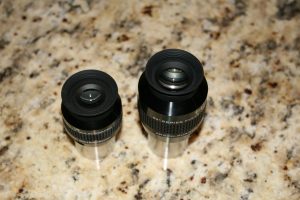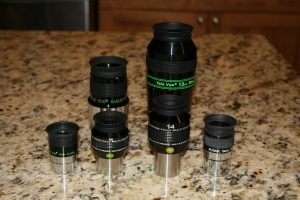Explore Scientific Eyepiece Review
When I first bought my first telescope in the 1970, there were many types of eyepieces to choose. The designed had names like Ramsden, Erfle, Huygen, Kellner, König and Orthoscopic, to name a few. Each had pros and cons. Eye relief, exit pupils, and field of view (FOV) were much smaller than today’s offerings. I still have my favorite 18mm Orthoscopic and a few Ramsdens. The Orthoscopic is great for viewing planets and Ramsdens are still the safest (for the eyepiece) design to use for solar projection.
In the 1980s, Plössl eyepieces started showing up everywhere and became very popular. Plössl provided a then large 50° or more apparent FOV. With high quality glass and lens coatings, Plössls provide high-contrast, symmetric views. They still are made and sold today.
I predominantly used Plössl eyepieces in the 1980s and 1990s. Then I discovered Tele Vue Nagler eyepieces. I felt Naglers were the best eyepieces made. Many longer focal length Naglers came with 2-inch barrels. They all have great eye relief, large exit pupils and an 82° FOV. The quality is superb. I owned 31mm, 26mm 22mm, 20mm, 12mm, 5mm and 4.8mm models.
More recently, I tested some Tele Vue Ethos eyepieces along with my Naglers. The 100° FOV is quite impressive, almost too much to take in. The FOV is so large I have to pan my eyeball around to see everything the eyepieces capture.
I eventually traded in my 12mm Nagler for a 13mm Ethos to use with my 14-inch f/6 Dobsonian telescope. My 12mm yielded 178x with this telescope. Even with the eyepiece’s 82° FOV, objects did not stay in the eyepiece very long before I needed to nudge the telescope. With the 13mm Ethos, the magnification is slightly lower (164x). Aided by the 100° FOV, objects are in the eyepiece much longer without moving the telescope. Today I predominantly use three Tele Vue eyepieces: the 2-inch 26mm Nagler, the 2-inch 13mm Ethos and the 1.25-inch 5mm Nagler.
My Nagler and Ethos eyepiece are superb, and I feel are the best I have ever used. However, I have had two challenges with them. First several of my telescopes do not have enough back focus range for the longer focal length (12mm and longer) eyepieces to focus. Therefore, I have to use a focuser extended. Second, the 2-inch eyepieces are heavy.

They are so heavy that I cannot use them with my 70mm apo (see ATT, volume 11, issue 2) on my iOptron Cube Pro (see ATT, volume 10, issue 6) mount. They are also heavy with my 190mm Mak-Newt (see ATT, volume 11, issue 6), since I use rotating tube rings with that telescope. The weight of the eyepieces causes too much rotational torque on the tube.
Thus, I began a search for some high quality 1.25-inch eyepieces to augment my arsenal of 2-inch eyepieces. I did a lot of research and decided to try out Explore Scientific 68° and 82° eyepieces. My opinions of the eyepieces are available in this Explore Scientific Eyepiece Review.
Image 1 shows the two eyepieces I purchased. On the left is the 14mm 82° eyepiece and on the right is the 16mm 68° eyepiece. Each came in the typical foam-padded Explore Scientific box with the decorative star-chart covers. They also came with top and bottoms dust caps.
To achieve the wide FOV, eliminate chromatic aberration, and provide sharp flat fields, these eyepieces use 6-7 elements of dense crown, light crown, dense flint, and lanthanum optical glasses. The eyepieces are waterproof and sealed with inert argon gas between the elements. The argon purges any moisture that might condense on the lenses during cold weather use.
The eyepieces are ruggedly manufactured with high quality materials. Each are serrated for ease of gripping either barehanded or with winter gloves. The eyepieces come with roll-up rubber eye guards that can be removed and easily replaced if they become worn.

The 16mm 68° eyepiece is 62mm tall, 43mm wide and weighs 158g (5.5 oz.). The eye relief is around 12mm with a field stop diameter of 18mm. Although the focal length is smaller, the 14mm 82° eyepiece is the larger of the two. It is 83mm tall, 48mm wide and weighs 256g (9.0 oz.). It has 15.6mm of eye relief and a field stop diameter of 18.9mm. In a 1000mm focal length telescope, the 14mm provide 71.4x magnification, while the 16mm provides 62.5x. Image 2 shows the top of the eyepieces with the generous diameter of the glass.
Image 3 shows the two eyepieces standing next to several other eyepieces for comparison. Bracketing the Explore Scientific eyepieces are two Plössl eyepieces with similar focal lengths. One is a Tele Vue Plössl, while the other is a generic Plössl. In addition, the photo shows a 9mm (borrowed) Tele Vue Nagler and a 13mm Tele Vue Ethos eyepieces. While the Explore Scientific eyepieces are notable beefier than the two Plössls, the Nagler and Ethos eyepieces dwarf them.
The true field of view of an eyepiece is calculated by dividing the apparent field of view, in this case 68° or 82°, by the effective magnification. In ends up both Explore Scientific eyepieces provide the same true FOV. The true FOV for 1000mm focal length telescope is 1.1° (82 ÷ 71.4 or 68 ÷ 62.5). So I expected to see the same view when interchanging them in the focuser, with the exception of the field being more spread out in the 82° eyepiece. And that’s exactly what I saw.

I tested each eyepiece in a 132mm f/7 apochromatic refractor and in a 190mm f/5.3 Maksutov-Newtonian reflector. Not only did I compare the eyepieces to each other, but I also compared them with a 13mm Tele Vue Ethos eyepiece, a 9mm Tele Vue Nagler eyepiece and a 15mm Tele Vue Plössl eyepiece (Image 4). The former and the latter of those three provided comparable magnification, while the 9mm resulted in a noticeable higher power,
Both Explore Scientific eyepieces provide sharp, high contrast views with pinpoint stars throughout the FOV. The same was true with the 9mm Nagler and the 13mm Ethos. The views through all four were superior the 15mm Plössl, where the stars were not as sharp near the edges.
Both the 68° and 82° Explore Scientific eyepieces performed splendidly. The choice of whether to use the 68° and 82° Explore Scientific eyepieces boils down to two factors. One is FOV. I prefer the wider FOV of the 82° eyepiece over the 68° eyepiece. The other factor is cost. The 82° cost more than the 68° eyepieces. Buyers must weigh those two factors before purchasing.
After testing the two 68° and 82° Explore Scientific eyepieces, I decided to stick with the 82° eyepieces and bought two additional ones. My set now consists of the 6.7mm, the 8.8mm, and the 14mm. I also wanted one around 24mm to use in lieu of my similar focal length, but much heavier 26mm Nagler. The Explore Scientific 24mm 82° did not come in a 1.25-inch barrel option, so I went with the 68° 24mm eyepiece.
My Tele Vue eyepieces will still be my workhorse oculars when using my 14-inch Dob; my 132mm apo; and with my 70mm apo, when I have it mounted piggyback on a larger instrument or by itself on either my Celestron CGEM II or AVX mounts.
However, my new set of 82° Explore Scientific 1.25-inch eyepieces will be my primary eyepieces when using my 190mm Mak-Newt, or when I am travelling light with my 70mm apo with either my iOptron Cube Pro mount or my Explore Scientific Twilight II mount. As you can see from this Explore Scientific Eyepiece Review I think I am finally set for life with high quality telescope eyepieces!
 And to make it easier for you to get the most extensive news, articles and reviews that are only available in the magazine pages of Astronomy Technology Today, we are offering a 1 year subscription for only $6! Or, for an even better deal, we are offering 2 years for only $9. Click here to get these deals which only will be available for a very limited time. You can also check out a free sample issue here.
And to make it easier for you to get the most extensive news, articles and reviews that are only available in the magazine pages of Astronomy Technology Today, we are offering a 1 year subscription for only $6! Or, for an even better deal, we are offering 2 years for only $9. Click here to get these deals which only will be available for a very limited time. You can also check out a free sample issue here.



